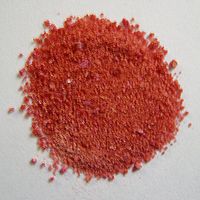- Cobalt(II) sulfate
-
Cobalt(II) sulfate Cobalt(II) sulfateIdentifiers CAS number 10124-43-3  ,
,
13455-64-0 (monohydrate)
10026-24-1 (heptahydrate)PubChem 24965 ChemSpider 23338 
UNII H7965X29HX 
EC number 233-334-2 ChEBI CHEBI:53470 
RTECS number GG3100000 (anhydrous)
GG3200000 (heptahydrate)Jmol-3D images Image 1 - [Co+2].[O-]S([O-])(=O)=O
Properties Molecular formula CoSO4 Molar mass 154.996 g/mol (anhydrous)
173.01 g/mol (monohydrate)
281.103 g/mol (heptahydrate)Appearance reddish crystalline (anhydrous, monohydrate)
pink salt (heptahydrate)Density 3.71 g/cm3 (anhydrous)
3.08 g/cm3 (monohydrate)
2.03 g/cm3 (heptahydrate) [1]Melting point 735 °C (anhydrous)
74 °C (heptahydrate)Solubility in water 36.2 g/100 ml (20°C) Hazards MSDS JT Baker MSDS EU Index 027-005-00-0 EU classification Carc. Cat. 2
Muta. Cat. 3
Repr. Cat. 2
Toxic (T)
Dangerous for the environment (N)R-phrases R49, R60, R22, R42/43, R68, R50/53 NFPA 704 Flash point Non-flammable LD50 424 mg/kg  sulfate (verify) (what is:
sulfate (verify) (what is:  /
/ ?)
?)
Except where noted otherwise, data are given for materials in their standard state (at 25 °C, 100 kPa)Infobox references Cobalt(II) sulfate is the inorganic compound with the formula CoSO4. It is the divalent cobalt salt of sulfuric acid. The most common form of cobalt sulfate are the hydrates CoSO4.7H2O and CoSO4.H2O. Cobalt(II) sulfate and its hydrates are some of the most commonly available salts of cobalt.
Contents
Properties
Cobalt(II) sulfate appears as red monoclinic crystals that melt around 100 °C and become anhydrous at 250 °C. It is soluble in water, slightly soluble in ethanol, and especially soluble in methanol. It forms by the reaction of metallic cobalt, its oxide, hydroxide, or carbonate with sulfuric acid. Cobalt is obtained from ores via the sulfate in some cases.[2][3]
Uses
Cobalt(II) sulfate is used in the preparation of pigments, as well as in the manufacture of other cobalt salts. Cobalt pigment is used in porcelains and glass. Cobalt(II) sulfate is used in storage batteries and electroplating baths, sympathetic inks, and as an additive to soils and animal feeds.[2][4]
Health issues
Cobalt(II) sulfate has been shown to be toxic and slightly carcinogenic upon inhalation in mice.[5] It has also been shown to be a mutagen in salmonella.[6]
It was added to the list of substances of very high concern in the European Union on 15 December 2010.
References
- ^ Lide, David R. (1998). Handbook of Chemistry and Physics (87 ed.). Boca Raton, FL: CRC Press. pp. 4–67; 1363. ISBN 0-8493-0594-2
- ^ a b John D. Donaldson, Detmar Beyersmann "Cobalt and Cobalt Compounds" in Ullmann's Encyclopedia of Industrial Chemistry 2005, Wiley-VCH, Weinheim. doi:10.1002/14356007.a07_281.pub2
- ^ Rarely, cobalt(II) sulfate is found in form of few crystallohydrate minerals, occurring among oxidation zones containing primary Co minerals (like skutterudite or cobaltite). These minerals are: biebierite (heptahydrate), moorhouseite (Co,Ni,Mn)SO4.6H2O, aplowite (Co,Mn,Ni)SO4.4H2O and cobaltkieserite (monohydrate).
- ^ Cobalt Sulfate
- ^ JR Bucher, JR Hailey, JR Roycroft, JK Haseman, RC Sills, SL Grumbein, PW Mellick and BJ Chou (1999). "Inhalation toxicity and carcinogenicity studies of cobalt sulfate". Toxicological Sciences 49 (1): 56. doi:10.1093/toxsci/49.1.56. PMID 10367342. http://toxsci.oxfordjournals.org/cgi/content/abstract/49/1/56.
- ^ Cobalt sulfate heptahydrate: Carcinogenic Potency Database
Cobalt compounds Categories:- Cobalt compounds
- Sulfates
- IARC Group 2B carcinogens
Wikimedia Foundation. 2010.


